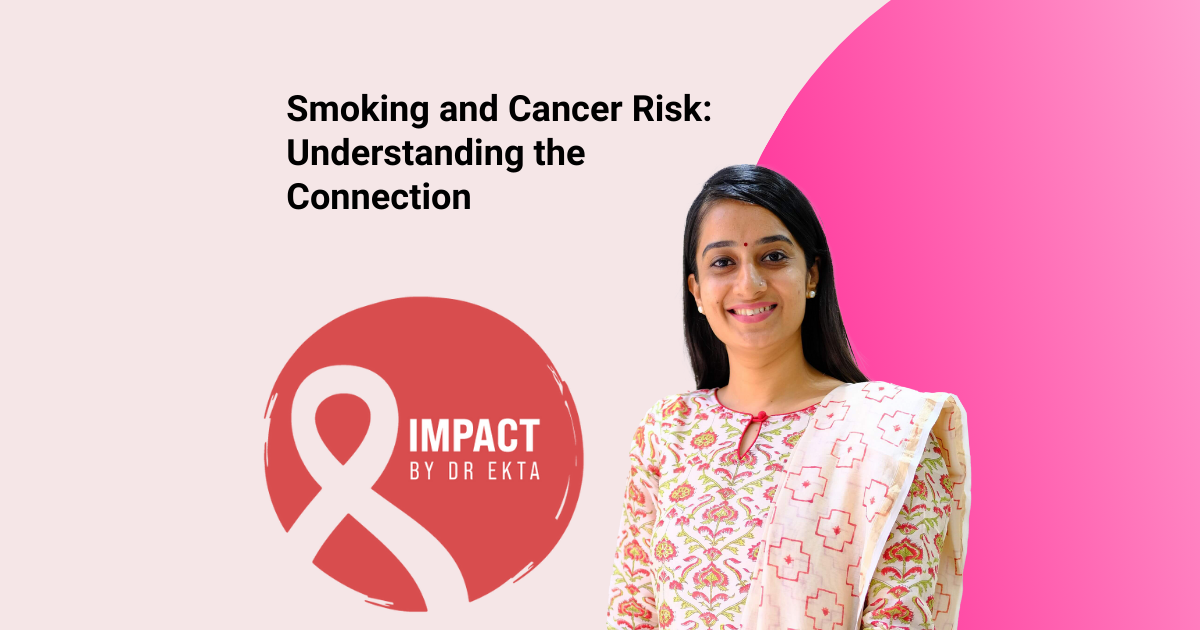Hello, I’m Dr. Ekta Vala, an oncologist dedicated to understanding and mitigating the factors contributing to cancer. Today, on World No Tobacco Day 2024, I want to shed light on a critical issue that has affected countless lives: the connection between smoking and cancer risk.
The Profound Impact: Smoking and Cancer Risk
As an oncologist, I’ve witnessed firsthand the devastating effects of smoking on patients’ health. The correlation between smoking and cancer risk is both significant and alarming. Smoking is a primary cause of various cancers, including lung, throat, mouth, esophagus, pancreas, bladder, and more. In fact, it’s responsible for a substantial percentage of cancer-related deaths worldwide.
How Smoking Increases Cancer Risk
When discussing smoking and cancer risk, it’s essential to understand the underlying mechanisms. Smoking introduces a plethora of carcinogenic substances into the body. Tobacco smoke contains over 7,000 chemicals, many of which are toxic and at least 70 are known carcinogens. These harmful substances include polycyclic aromatic hydrocarbons (PAHs), tobacco-specific nitrosamines, and a variety of other chemicals that can cause significant damage to our cells.
These carcinogens can lead to mutations in DNA, which is a fundamental step in the development of cancer. The DNA damage caused by smoking weakens the immune system, making it less capable of fighting off cancer cells. This, in turn, significantly increases the risk of developing cancer.
Types of Cancer Linked to Smoking
The link between smoking and cancer risk is most evident in lung cancer. About 85% of lung cancer cases are attributed to smoking, making it the leading cause of lung cancer deaths. However, the impact of smoking extends beyond the lungs. It’s a major risk factor for cancers of the mouth, throat, esophagus, pancreas, bladder, kidney, cervix, and even some types of leukemia.
The Role of Secondhand Smoke
It’s also important to highlight the dangers of secondhand smoke in the context of smoking and cancer risk. Non-smokers exposed to secondhand smoke are at an increased risk of developing lung cancer. The carcinogens in secondhand smoke are just as dangerous as those inhaled directly by smokers. Children exposed to secondhand smoke are particularly vulnerable, which underscores the importance of smoke-free environments.
Protecting Children from Tobacco Industry Interference
Its the theme of World No Tobacco Day 2024 i.e. “Protecting Children from Tobacco Industry Interference.” This theme highlights the urgent need to shield our youth from the manipulative tactics of the tobacco industry. Tobacco companies often target young people through advertising, sponsorship, and promotional activities designed to make smoking appear glamorous and appealing.
As an oncologist, I am deeply concerned about the long-term health impacts this has on children. When children and adolescents start smoking at a young age, their risk of developing cancer later in life increases dramatically. By protecting children from the influences of the tobacco industry, we can significantly reduce smoking initiation rates and, consequently, lower cancer risk in future generations.
The Importance of Quitting Smoking
As an oncologist, I cannot stress enough the importance of quitting smoking. The benefits of quitting are immediate and long-lasting, significantly reducing the risk of cancer. Within minutes of quitting, your body begins to recover. Heart rate drops, carbon monoxide levels in the blood decrease, and over time, lung function improves. Within a year, the risk of coronary heart disease is about half that of a smoker’s, and after 10 years, the risk of lung cancer drops to about half that of a smoker’s.
Support and Resources for Quitting
Quitting smoking is challenging, but it’s achievable with the right support and resources. There are numerous smoking cessation programs available that provide counseling, medications, and support groups. Healthcare providers, including oncologists like myself, are always ready to assist patients in their journey to quit smoking. The key is to take that first step and seek help.
The Role of Awareness and Education
On this World No Tobacco Day, it’s crucial to emphasize the importance of awareness and education in reducing smoking and cancer risk. Public health campaigns play a vital role in informing people about the dangers of smoking and the benefits of quitting. Educational initiatives in schools, workplaces, and communities can help prevent people from starting to smoke and encourage smokers to quit.
A Call to Action
As we observe World No Tobacco Day 2024, I urge everyone to reflect on the profound connection between smoking and cancer risk. Whether you’re a smoker, a former smoker, or a non-smoker, we all have a role to play in reducing the prevalence of smoking and its associated risks. If you smoke, make today the day you commit to quitting. If you know someone who smokes, offer them support and encourage them to seek help. Together, we can work towards a future with less cancer and healthier lives.
Conclusion
Understanding the connection between smoking and cancer risk is essential for both prevention and intervention. As an oncologist, I am committed to spreading this crucial message. By raising awareness and supporting efforts to quit smoking, we can significantly reduce the incidence of cancer and improve public health. Let’s take a stand against smoking and make a difference in the fight against cancer.
Let’s also focus on protecting our children from the predatory tactics of the tobacco industry, ensuring a healthier, smoke-free future for the next generation.
Thank you for your attention, and let’s work together to create a healthier, smoke-free world.

